COLLEGIATE CLUB ROWING KEEPS GROWING



COLLEGIATE CLUB ROWING KEEPS GROWING















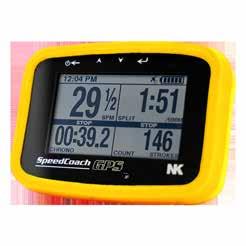





 Photo credit: FBM Photography
Photo credit: FBM Photography


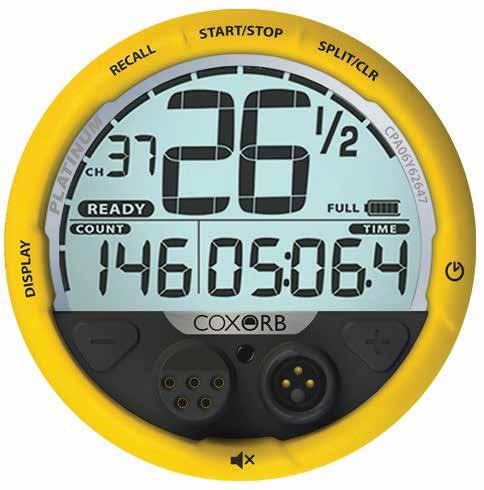


Chip Davis PUBLISHER & EDITOR
Chris Pratt ASSOCIATE PUBLISHER
Vinaya Shenoy ADMINISTRATIVE ASSISTANT
Art Carey ASSISTANT EDITOR
Madeline Davis Tully ASSOCIATE EDITOR
CORRESPONDENT
Rich Davis
CONTRIBUTING WRITERS
Andy Anderson | Nancy Clark
Kayleigh Durm | Bill Manning
Volker Nolte | Marlene Royle
CONTRIBUTING PHOTOGRAPHERS
Jim Aulenback | Steve Aulenback
Stewart Cohen | Karon Phillips
Tom Walsh | Lisa Worthy
MAILING ADDRESS








Editorial, Advertising, & Subscriptions PO Box 831 Hanover, NH 03755, USA (603) 643-8476
ROWING NEWS is published 12 times a year between January and December. by The Independent Rowing News, Inc, 53 S. Main St. Hanover NH 03755 Contributions of news, articles, and photographs are welcome. Unless otherwise requested, submitted materials become the property of The Independent Rowing News, Inc., PO Box 831, Hanover, NH 03755. Opinions expressed by authors do not necessarily reflect those of ROWING NEWS and associates. Periodical Postage paid at Hanover, NH 03755 and additional locations. Canada Post IPM Publication Mail Agreement No. 40834009 Return undeliverable Canadian addresses to Express Messenger International Post Office Box 25058 London BRC, Ontario, Canada N6C 6A8.
POSTMASTER: Send address changes to: ROWING NEWS
PO Box 831, Hanover, NH 03755. ISSN number 1548-694X
ROWING NEWS and the OARLOCK LOGO are trademarks of The Independent Rowing News, Inc. Founded in 1994
©2024 The Independent Rowing News, Inc. All rights reserved. Reproduction in whole or in part without written permission prohibited.
PLEASE SHARE OR RECYCLE THIS MAGAZINE



Follow Rowing News on social media by scanning this QR code with your smart phone.

FEATURES
It was the most successful regatta ever for RowAmerica Rye, which was founded in 2013 and qualified 19 boats and 134 athletes for the championship. Thirteen crews made the A final, and 11 of those boats medaled.
BY MADELINE DAVIS TULLYTexas wins its third national title in four years, as Western Washington takes the Division II title and Tufts wins the Division III Championship.
BY MADELINE DAVIS TULLYWashington records an historic weekend, Princeton women repeat as lightweight national champions, and Harvard lights go one-two.
BY CHIP DAVISDEPARTMENTS
News The Eights Are Back, Race Reports Harvard-Yale Rockland Masters Regatta
Sports Science When the Stars Align Coxing Getting Back Into It
Best Practices The Etiquette of Selection Camp Fuel Better Rowing Through Food Science Training Schooled in Sculling Coach Development Your Move 14 From the Editor 66 Doctor Rowing







One of the great things about writing for Rowing News is that you get to interview the best in our sport, and often at one of the high points of their careers. The end-of-spring championship season is the most important time of the year for youth and college crews, the largest segment—over 85 percent, by our count—of American rowing.
This year’s championships were some of the best ever, by many measures. Collegiate club rowing continues its healthy growth, in terms of both speed and participation, as seen at the American Collegiate Rowing Association’s ACRA National Championship Regatta (see page 52). Varsity lightweight and men’s heavyweight programs, including Division III, had their biggest year ever at the Intercollegiate Rowing Associations’s 121st IRA National Championship Regatta.
Improving—and thereby enhancing experiences in rowing—can sometimes mean delivering frank and constructive criticism. Rowing News proudly delivers.

As the only publication covering these events in a glossy fullcolor print magazine, it’s not only a joy but also part of our reason for being. The three fundamental purposes of Rowing News are to recognize excellence, to inspire rowers, and to enhance the rowing experiences of the community we serve. In this issue’s pages, you’ll see this year’s champions and read some of the stories of how they got there.
Improving—and thereby enhancing experiences in rowing— can sometimes mean delivering frank and constructive criticism. As North America’s independent source of professional rowing journalism, Rowing News proudly delivers.
Racing among the top college crews should, of course, be faster than youth crews, and expectations for the quality of the championship regattas should, logically, be higher as well. But the reality in American rowing this year is exactly opposite, at least when it came to USRowing’s Youth National Championship and the NCAA Women’s Rowing Championships.
The award-winning Youth Nationals (SportsTravel’s 2023 Best Amateur Sporting Event) grew and improved yet again in 2024, attracting 4,058 athletes and 5,507 paying spectators to America’s premier racecourse to crown youth national champions in 41 events. With the continued success of the event, USRowing is setting ever-higher benchmarks of what can be achieved by professionally managed regattas at world-class venues.
The NCAA, on the other hand, despite having full fields of the best trained, supported, and prepared oarswomen in the history of our sport, put on a regatta fully deserving of the blistering critique offered by guest contributor Etta Carpender on page 45. While Carpender had the privilege of competing for (and winning, for a second time) the Division I national championship on the water, she and her fellow competitors suffered conditions on shore that fell short of what a national championship should provide.
Today’s college champions are tomorrow’s Olympians, as is the case again this year. As I detail in Big News, beginning on page 25, the U.S. squad headed to Paris is made up entirely of IRA and NCAA collegiate rowers. The expectation is that our best will race in the best regatta in the world and win at least four medals, including gold.
And you can count on Rowing News to report on it all.


In the June issue, we misspelled the name of U.S. Paralympic coxswain Emelie Eldracher. Eldracher and her PR3 mixed four teammates won silver at World Rowing Cup III in Poznan, Poland, June 16 . Eldracher, Ben Washburne, Alex Flynn, Skylar Dahl, Gemma Wollenschlaeger finished second to Great Britain, holders of a 13-year world and Paralympic winning streak. France finished third. The Paris 2024 Paralympic Games take place Aug. 28 to Sept. 8, with Para rowing events Aug. 30 to Sept. 1.
‘24
GIRLS. AGES 13-18. ALL SKILLS.
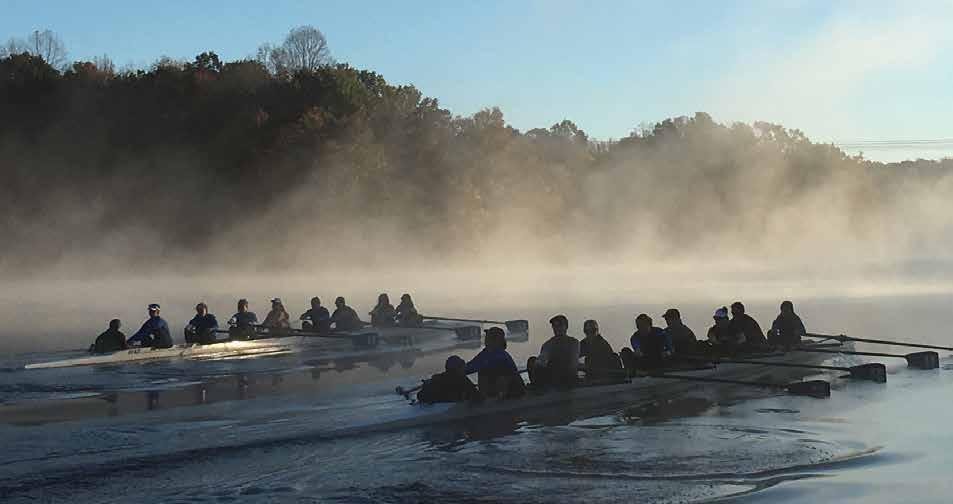

Seattle Pacific University
June 24-28, July 8-12
University of Portland
July 21-25
July 30-Aug 2, August 13-16 Briones Resevoir Boathouse August 6-9 WOMEN’S ROWING
Gary Rogers Rowing Center July 29-August 1, August 5-8


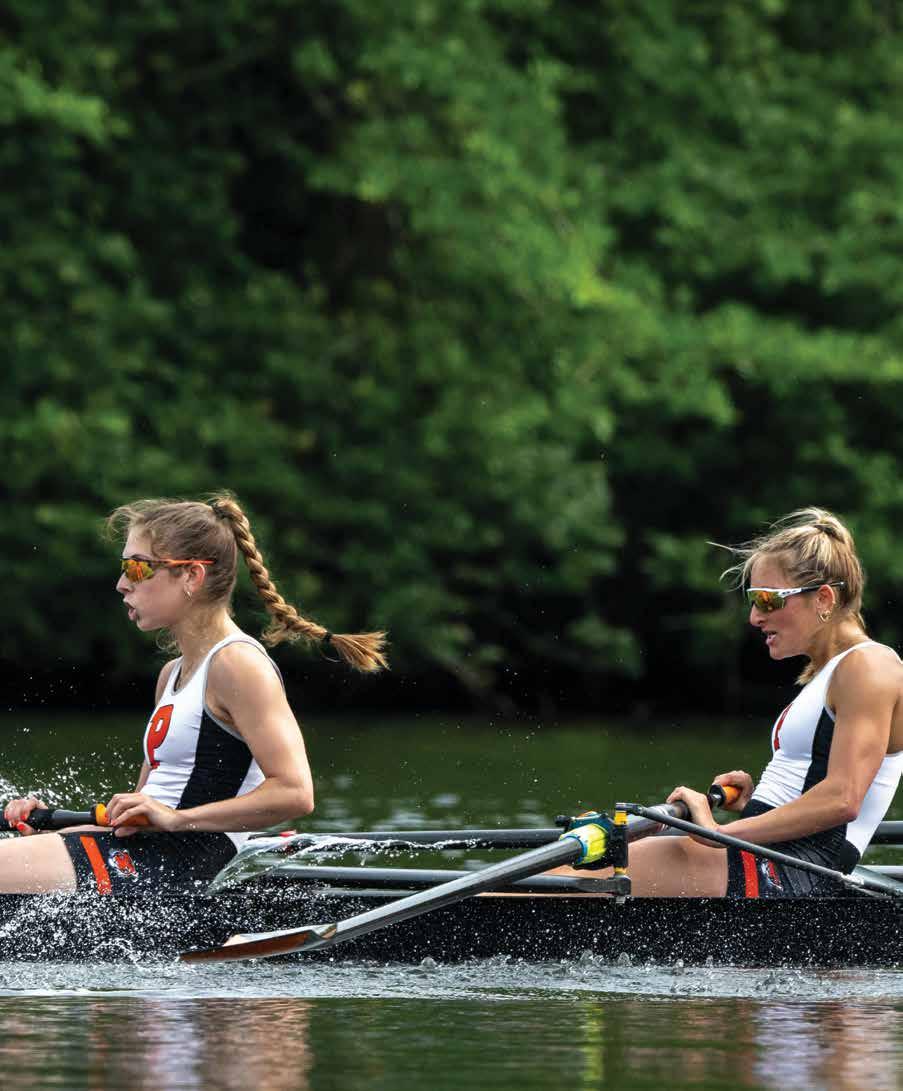
The Collegiate Rowing Coaches’s Association named Princeton’s Sarah Fry the CRCA Lightweight Athlete of Year after she stroked the first varsity eight—which never lost during her time at Princeton—to the Tigers’ third-straight IRA Commisioners’ Cup and national championship. Coach Paul Rassam, whose varsity has not lost to another lightweight crew in five years, earned CRCA Lightweight Coach of the Year honors.


Washington (2024) and Cal (2023) combined for back-to-back sweeps of the Intercollegiate Rowing Association national championships in the last two years of the Pac-12’s existence as a rowing conference. The Huskies won the third varsity grand final of the 2024 IRA in 5:39, a time that could have won the first varsity event 25 years ago.

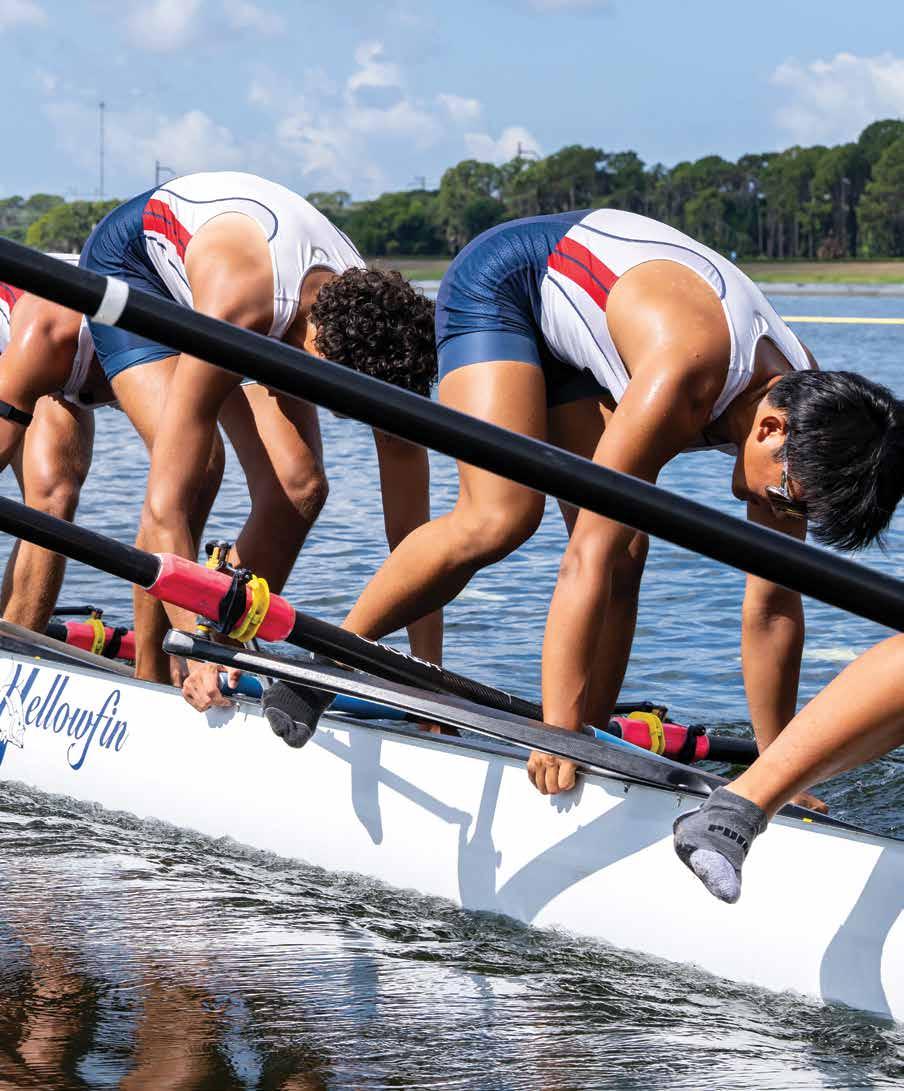
Sarasota Crew launches with panache at the 2012 USRowing Youth National Championships at Nathan Benderson Park, Sarasota, Fla. National titles were awarded in 41 events, contested by 4,058 athletes in 853 boats from 224 clubs.


The U.S. could capture at least four medals, including gold, at the Olympic Games in July.
U.S. Olympic eights are back, and not just in the Games (for which the U.S. men had to go through the last-chance Final Olympic & Paralympic Qualification Regatta) and are in contention for medals, including gold.
And for a change, a very deliberate one achieved by the athletes, coaches, and clubs that have bought into the plans and direction of USRowing’s chief performance officer Josy Verdonkschot, U.S. crews are favored to medal in sculling, small boat, and lightweight events—as well as in the almighty eights.
“We did a pretty good job as a team,” said Verdonkschot after the U.S. qualified four more crews for the Olympics at the FOPQR—bringing the U.S. total to 12 of 14 Olympic events. “We are in a good spot right now.
“You have to understand that if you can
win the qualifiers, you can race for medals. So I would be lying if I said I would be satisfied with just six A finals.”
A more likely and satisfying outcome in Paris will be four medals.
“At least one of them shiny [meaning gold],” said Verdonkschot.
With the demonstrated speed of the fours, the women’s doubles—both lightweight and open boats earned medals at last year’s Worlds—and the potential of the men’s double and women’s quad, the return of U.S. eights could mean more than four medals for the U.S. at the Olympic regatta (July 27 to Aug. 4).
Asked if he was proud of the women in the U.S. quad after they qualified for Paris at May’s FOPQR, Verdonkschot didn’t hesitate.
“Yeah, I’m really proud. They really executed. It was
After 42 years of making and servicing oars and sculls, Bob Beeman is retiring, Concept2 announced.
A familiar and friendly face at regattas across North America and around the world, Beeman has saved the day for many, from novices to Olympians.
“A man proud of his craft can be found fixing anything, from oars at the Head of the Charles Regatta to a spectator’s leather boots at Henley Royal Regatta,” the oar and erg company said in a statment. “You may still see him traveling to a few events doing oar repair, though.”
Thumbs up to a man known for giving them, with a smile.
perfectly done. And I think I’m particularly proud because in the end we qualified 12 boats.
“Quantity is good. But that doesn’t really satisfy me. Quality is what counts in Paris.”
While the boats that needed to qualify raced in Lucerne, the already qualified crews trained on Italy’s Lago di Pusiano.
“They had a good camp in Italy,” said Verdonkschot, reached by phone before he drove into the Gotthard Tunnel on his way to Pusiano from the FOPQR in Lucerne to join the crews headed to World Rowing Cup II, also held in Lucerne. “Those athletes who are right now in Pusiano, they will feel the vibes of this team. And they consider that a good indication of where they should stand.”
At the Lucerne World Rowing Cup II, the last international regatta to which countries bring their Olympic crews before the Games (Rowing World Cup III attracted mostly U23 and non-Olympic Worlds crews), the U.S. men’s eight won the meaningless “race for lanes” in lieu of heats, due to only six entries, before finishing second to defending world champion Great Britain by only two tenths of a second in the final. The Netherlands finished two seconds back in third, with both Australia and Germany seven seconds back in fourth and fifth.
The result represents a major step up from last year’s result at the world championships, when the fifth-place U.S. eight failed to qualify and was never in the mix. This year’s eight features a new lineup, completely reselected for the Olympic campaign.
“It’s been a very big team collaborative effort from Josy to Casey Galvanek, who’s the head and sweep coach and coaching the four. He did an outstanding job selecting this crew,” said University of Washington head coach Michael Callahan, who has coached this year’s boys in the boat since their March selection.
“These guys are really hard-working, very dedicated, very focused on the Olympics and performing well there. It’s really a crew, which is important. It’s not just a collection of eight talents and a cox. They are a crew and they’re working together very, very hard. It’s been fun to work with them in Seattle before the qualifier, and I’m looking forward to the
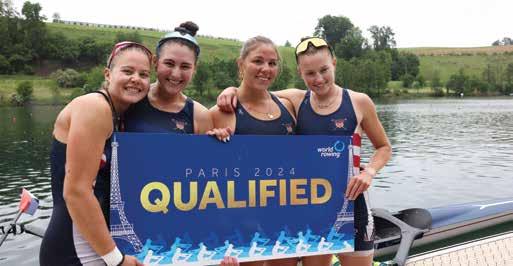
next four weeks here in Princeton before we go back to Europe.”
Because the women’s eight event was likely to be a straight final with fewer than seven entries, the request was made to World Rowing to allow three U.S. straight fours to race to give the athletes in the eight the opportunity to race in more than a final-only event.
The request was denied, continuing the disadvantage North American elite rowers suffer vis-a-vis their European rivals, who get the extra elite-level racing experience of the World Rowing-administered European Championships in April as well as the three Europe-based World Rowing Cups—all without crossing an ocean and changing time zones—in the lead-up to the Olympics.
The Jesse Foglia-coached women’s eight and four gained some international racing experience, if not victories, at Lucerne. Both crews raced to third-place finishes in the finals, the four in a field of seven, the eight against only three other crews. Canada was the surprise winner in the eight. Although Canada is the defending Olympic champion, this year’s crew is a mostly new line-up, with only three returning Olympic champions. Great Britain won the four and finished second in the eight. Notably absent was Romania, the clear favorites after winning last year’s world championship and this spring’s European championships with the same crew, save one athlete.
Both U.S. eights are potential Olympic medalists, even champions. The margins are typically tight in the big boats—both U.S. eights missed the medals by less than
one percent in Tokyo—and Romania’s fivemedal (two gold) mastery of women’s events at last year’s Worlds depended on their top athletes’ racing multiple events, something they are less likely to do in Paris. The U.S. eights have both the top-end talent and depth to end USRowing’s drought of no senior National Team wins since 2019.
While the women’s quad celebrated its Olympic qualification, the men’s quad raced incredibly, and painfully, close to doing the same, finishing short to Estonia by 13 one-hundredths of a second. If the event allowed 13 quads, as it did until recently, the U.S. would have snared a spot in the Games already. But with the reduction of the Olympic field to nine countries, the U.S. crew of Dominique Williams, Will Legenzowski, Liam Galloway, and Kevin Cardno—arguably America’s best men’s quad since the U.S. won silver at the 1996 Atlanta Games—miss out.
When USRowing named the Olympic rowing squad in June, Princeton head coach Lori Douphiny, Dartmouth head coach Wyatt Allen, and Cal associate head coach Adrienne Martelli were all included. The addition of top collegiate coaches fits well with the makeup of the squad: Every single one of the men rowed in college at a varsity IRA program, and all of the women rowed in college at a Division I NCAA program, except for four-time Olympian Megan Musnicki, who rowed at one of the top Division III schools, Ithaca College.
Dauphiny will coach the women’s pair of 2023 Stanford NCAA champion Azja Czajkowski and 2017 Washington
NCAA champion Jess Thoennes. Martelli also will assist head women’s sweep coach Jesse Foglia, concentrating on the four. Czajkowski and Thoennes finished second in their heat, third in their semi, and sixth in the grand final at Lucerne.
The men’s pair of Billy Bender and Oliver Bubb missed the grand final by a quarter of a second and then finished a disappointing fourth in the B final at Lucerne.
“They showed that they have the speed to be in the mix. Racing three days over a long weekend probably caught up to them and showed their youth a little bit,” said Allen, who coached both as undergraduates at Dartmouth and is their coach again this summer. “I think they’re gonna be right in it, come Paris.”
Besides Musnicki in the women’s Olympic eight for the fourth time and three-time Olympian Kara Kohler, who will be the U.S. single sculler, most of the squad—25 of 42—will be racing in their first Olympic Games. But they are far from inexperienced. All but four have previous senior National Team experience.
Single sculler Jacob Plihal earned his spot on the U.S. National Team and qualified for a place in the Olympic Games for the first time with a second-place (by less than two tenths of a second) finish at the FOPQR. Combined with the win by the men’s double of Sorin Koszyk and Ben Davison at the FOPQR and the already qualified and favored-to-medal women’s double of Sophia Vitas and Kristi Wagner, this year’s squad is the first in the qualification era to have earned entries in all four events: men’s and women’s singles and doubles.
Combined with the resurgent eights and the rest of the 12 qualified boats, U.S. Olympic rowing could have its best Games since LA84, and certainly better than the zero medals from the Covid-disrupted Tokyo Games in 2021.
Verdonkschot knows that speed in the spring is nice, but Olympic medals are won in the summer. USRowing qualified nine crews for Tokyo and won no medals. Qualifying three more for Paris doesn’t guarantee medals.
“Nine times zero is zero. Twelve times zero is also zero. So now we have to get back to work and make sure that we are fully prepared for Paris.”

Tori Stevens has a broad background in sports business.
The Head of the Charles has selected Tori Stevens as its next executive director.
She succeeds Fred Schoch, the pioneering first and only executive director the 59-year-old regatta has ever known. Schoch led the growth and development of what is now the largest and best-known rowing event in America.
Stevens comes to rowing from a career in sports business, including ESPN’s X Games, after working as CEO of SUP3R, an affiliated company of marketing and events powerhouse Superfly. She has held executive positions at GumGum Sports, the Sports and Innovation Lab, CSM Sports & Entertainment, and the Boston Consulting Group. Stevens also serves on the board of USA Pickleball.
“I’m honored to be selected as the next executive director of the Head of the Charles Regatta,” said Stevens. “I know we will build on the regatta’s legacy as we grow and innovate both in the sport of rowing and how we support our communities.”
The Head of the Charles, which claims to be the world’s largest rowing regatta, has faced funding challenges, first as brands moved away from event name sponsorship, then with increased costs after the Boston Marathon bombing and more recently Covid and inflation. Through it all, the event has been “Boston Strong,” relying on 2,400 volunteers, widespread community support, and funds banked during the regatta’s best financial years.
Stevens begins her new job July 1. In an exclusive interview with Rowing News the week before the announcement, she said no major changes are planned for next fall’s regatta (Oct. 18 to 20) and that her initial tasks include listening and learning more about rowing and the regatta.
“We were dedicated to finding a leader who would join us in our commitment to running a world-class regatta,” said Tim Fulham, chair of the HOCR board of directors, “and at the same time help us think proactively about the areas where we can continue to pioneer, grow, and improve.”

In the 157th race, the Crimson heavyweight varsity eight beat the Bulldogs by four seconds.
Harvard men’s heavyweight varsity claimed its first Harvard-Yale race win since 2014 with a victory over four miles, upstream on the Thames River, in New London, Conn. on Saturday, June 8. The Crimson took a commanding lead in the first half of the race and never looked back.
The oldest event in American collegiate sports continued for the 157th time. Harvard’s varsity had lost to Yale every year since 2014. This year, the Crimson beat the Bulldogs by a length, 19:40.2 to 19:44.8.
In the Friday night combination race, Yale’s fourth varsity took the victory. Yale kept the party going Saturday morning with wins in the third varsity and second varsity events, before Harvard won the main event.
“It’s not easy to continue the season an extra week after IRAs,” said Yale coach Mike Gennaro. “I couldn’t be happier for our second varsity, third varsity, and fourth varsity crews for their wins over Harvard, but am gutted for our varsity. Harvard’s varsity is fast and they rowed well today. This regatta and rivalry mean everything to our program.”
The Harvard first varsity eight consisted of Ben Ray (cox), Ben Scott (stroke), Josh Brangan, Tyler Horler, Cam Beyki, Leo Bessler, Gabe Obholzer, Tom O’Sullivan, and Tom Horncastle.
Riverfront Recapture took first and second place in the men’s masters/ open eight at the Rockland Masters Regatta, June 15, in Rockland, N.Y.
The one-two finish was one of six victories for Riverfront Recapture and the fastest race of the regatta
“It was great,” said Rockland Rowing’s Ivan Rudolph-Shabinsky. “Last year, we had 91 entries, and this year it was 264.”
New Haven Rowing Club’s decision to discontinue its Derby Sweeps and Sculls regatta to concentrate on the fall Head of the Housatonic left the June weekend open for Rockland Rowing’s event, and the two clubs let competitors know about the change and the opportunity to race at Rockland Lake State Park on the 10-lane, 1,000-meter course.
“People were very positive about the venue,” said Rudolph-Shabinsky.
Winds up to 25 m.p.h. necessitated the cancellation of small-boat events in the morning, and the start of racing was delayed until 1:30 p.m. Regatta organizers allowed competitors to rework lineups and entries.
“The highlight was everyone being flexible, lending out equipment. Things like that turned it around, and in the afternoon, we had some really good racing in eights, fours, and quads,” said Rudolph-Shabinsky.
The Rockland Relay capped the day with nine teams of 20 rowers each boating a double, a four, an eight, and a quad. Each boat raced 500 meters in one of two lanes allocated to its team, with the next boat racing back in the other lane after the preceding boat crossed the line.
Saratoga won three events: the women’s masters A-D quadruple sculls, the men’s masters quadruple sculls, and the mixed masters E-H quadruple sculls—in which they finished first and second in a field of eight (with one scratch).
“I’ve been telling USRowing that if they want to do [masters] Northeast Regionals here some time, we’d love to host that because we have a great venue,” said Rudolph-Shabinsky. “It’s a perfect course, we have a huge parking lot, and it’s in a state park. It’s a beautiful venue with a lot of space.”

A global initiative to promote inclusion and acceptance in the broader rowing community.
Add your own voice - take the online pledge!
Every signature is tallied by programme, by role, by community, and by country.
Congratulations to Station L Rowing Club - the most signatures*
Coming soon: an embeddable widget for your website showcasing the number of signatures for your programme.

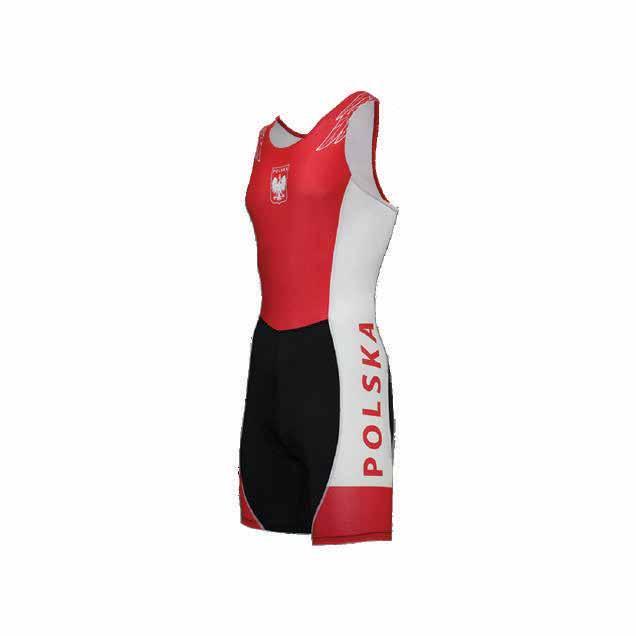
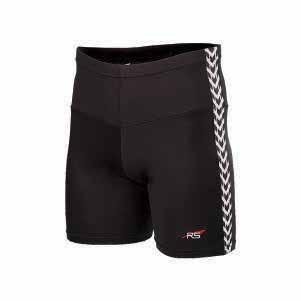



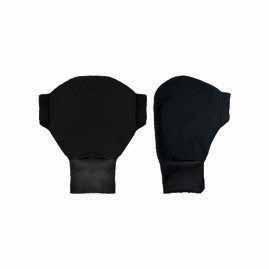





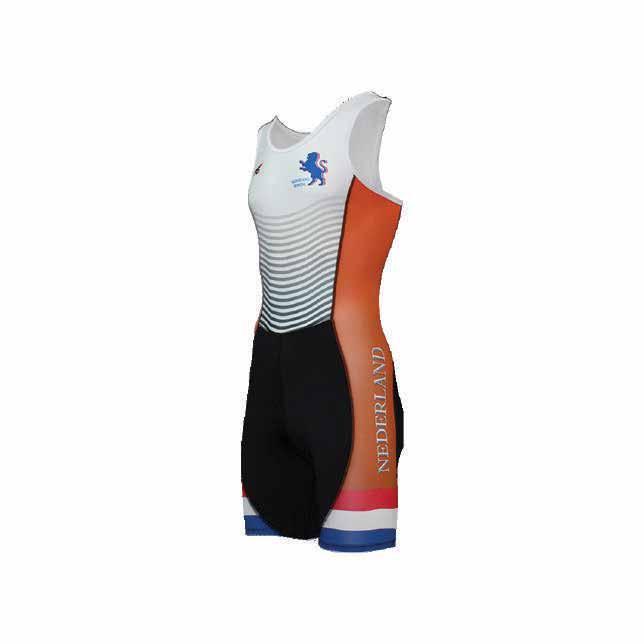





ALL AVAILABLE WITH YOUR TEAM LOGO AT NO EXTRA CHARGE (MINIMUM 12)
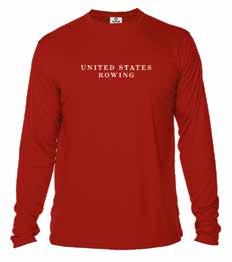
UNITED STATES ROWING UV
VAPOR LONG SLEEVE $40
WHITE/OARLOCK ON BACK
NAVY/CROSSED OARS ON BACK
RED/CROSSED OARS ON BACK
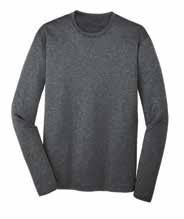
PERFORMANCE LONG SLEEVES

PERFORMANCE T-SHIRTS

PERFORMANCE TANKS
Order any 12 performance shirts, hooded sweatshirts, or sweatpants and email your logo to teamorders@rowingcatalog.com and get your items with your logo at no additional cost!

 SWEATPANTS
HOODED SWEATSHIRTS
SWEATPANTS
HOODED SWEATSHIRTS










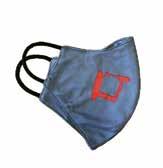

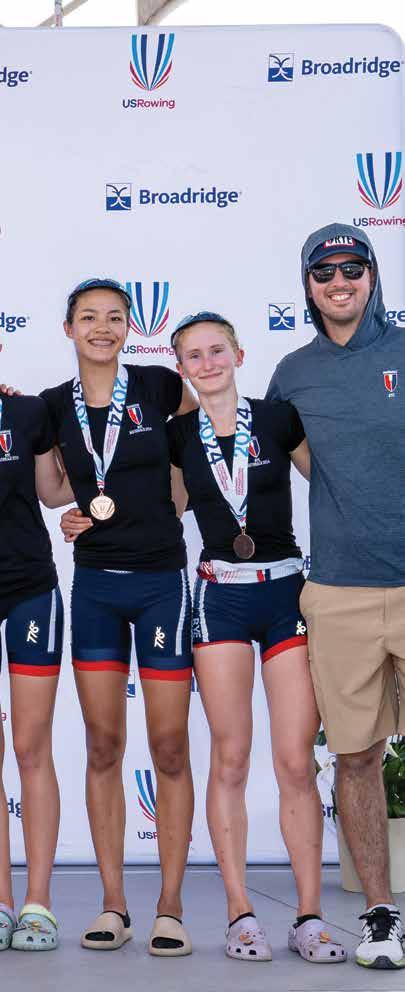
IT WAS THE MOST SUCCESSFUL REGATTA EVER FOR THE PROGRAM, WHICH WAS FOUNDED IN 2013 AND QUALIFIED 19 BOATS AND 134 ATHLETES FOR THE CHAMPIONSHIP. THIRTEEN CREWS MADE THE A FINAL, AND 11 OF THOSE BOATS MEDALED.
Forty-one new youth national champions were crowned on June 9 at Nathan Benderson Park in Sarasota as the 2024 USRowing Youth National Championships came to a close. This year’s event was the largest ever, featuring over 4,000 athletes competing in 854 crews from 225 clubs across the country.
RowAmerica Rye dominated the eights events, winning both the men’s and women’s varsity eights. They also finished first and second in the women’s second varsity eight in addition to finishing second and fourth in the men’s second varsity eight.
Furthermore, RowAmerica Rye won the men’s U16 eight and the women’s U17 eight. This is the most successful regatta for the program, which was founded in 2013 and qualified 19 boats and 134 athletes for the championship. Thirteen crews made the A final, and 11 of those boats medaled.
STORY BY MADELINE DAVIS TULLY PHOTOGRAPHY BY LISA WORTHYRowAmerica Rye rows out of the Rye (New York) Municipal Boat Basin and brought 19 crews to Sarasota’s Nathan Benderson Park, returning home with medals from 11 events.

This is the first varsity eight win for the RowAmerica Rye women, who defeated last year’s bronze medalists, Newport Aquatic Center, by 1.6 seconds and Marin, the 2023 defending champion, by two seconds.
Meanwhile, the men defended their 2023 title, winning a barnburner of a final with just over five seconds separating the top seven crews. While RowAmerica Rye came across the finish line 1.7 seconds ahead of St. Joseph’s Prep, less than one second separated third through fifth places.
Marko Serafimoski, director of rowing and head girls coach at RowAmerica Rye, credits the core group of four coaches who have been there since the beginning—Aleksandar Radovic, Filip Topalovic, Stan Nelson, and himself— with “developing the system and structure, implementing the culture, and creating standards as well as raising those standards as the club’s performance grew.”
“This year’s success came through months and, for some, years of hard work that these young athletes have put in. It was beautiful to see that all the hard work
has paid off, but most importantly it is beautiful to see how this sport and the journey these young athletes go through positively impact their lives and get them ready for greater challenges down the road. This is the true success.”
Los Gatos had its own dominating performance in the quad events, winning six medals. The club won the men’s youth quad as well as the men’s and women’s youth second varsity quad. Los Gatos also finished second in the women’s youth quad, women’s youth second varsity quad, and third in the men’s U17 quad.
This performance builds on last year’s successes, when the club came away with a silver medal in the men’s youth quad, men’s youth four, and women’s straight four, as well as a fourth-place finish in the women’s youth quad.
Before the racing kicked off, the team felt optimistic about its upcoming opportunity as LGRC Director Jaime Velez told the Los Gatan , “We’re looking to have an even stronger year this year. We believe we have a really good shot of medaling in quite a few of those entries.”
In the women’s quad event, the
Redwood Scullers came away with the win after finishing second last year to Oregon Unlimited, which finished a very close third in this year’s iteration of the event.
Ian O’Riley from Brophy College Preparatory Crew brought home the gold in the men’s youth single by nearly six seconds. He qualified for the regatta with a dominating performance at the USRowing Southwest Youth Championships, where he won the men’s youth singles event by nearly 30 seconds after finishing third at Youth Nationals last year.
“Ian’s performances this year were incredible,” said Brophy head coach Pete Cannia. “I couldn’t be prouder of him and all his hard work and dedication. I am incredibly proud of our program’s inspiration and the daily Brophy Crew winning culture it brings.”
O’Riley has committed to row at Harvard next year and will compete at the upcoming U19 National Team Trials.
In the women’s youth single, U.S. National Team member Annelise Hahl, representing Triangle Rowing, took home gold after finishing third in the same event last year. No stranger to elite competition,

Hahl placed 11th in the single at the 2023 World Rowing Under 19 Championships. She also competed at the 2023 World Rowing Beach Sprint Finals, where she finished second in the junior women’s solo and reached the quarterfinals of the junior double sculls.
In a heartbreaking moment, the Montclair men’s pair, who were in the lead at the time, flipped with only 250 meters to go in the A final. Liam Feeney and Isaiah Aljuwani from Canisius High School, who were in a close second, kept their cool, took the lead, and the gold. Notably, a second Canisius pair took silver in the same event.
In another race of note, Community Rowing, Inc’s Maria Prodan won the women’s U17 single by a comfortable 11.5 seconds. Prodan, who is Ukrainian, fled the country with her family after the Russian invasion. Her father, Anton Prodan, has coached multiple Ukrainian rowers to Olympic and world championship success and now coaches his own daughter on the Charles River.
In one of the most impressive feats of the weekend, the Connecticut Boat
Club crew of Annika Nelson and Caroline Krantz defended their 2023 title with a win in the women’s pair event early Sunday morning by over two and a half seconds.
A mere 90 minutes later, they joined with teammates Callaghan Nickerson and Sophie Bell to win the women’s youth straight four by over three seconds. The crews are coached by Liz Trond, who says this is something they’ve been talking about for a long time.
“We planted the seed a year ago,” Trond said. “We said, ‘We’re not going to talk about it all year, but if the pieces fall into place, if you guys are fit enough, maturity wise, it’d be a cool thing. Nobody’s ever done it.’”
CBC pulled off a similar feat in 2019 when they doubled up and won the pair and four with, but the straight four was introduced at the regatta only in 2022. Trond left the decision to Nelson and Krantz, who have rowed the pair together for three years and will continue to row together next year at Dartmouth College. They were game
Trond and her rowers emphasized
RowAmerica Rye finished second—and fourth—in the youth men’s U17 eight, one of several lower-level events at USRowing’s Youth Nationals that allows multiple entries from a single club.
the importance of moderating their effort across the six races, physically as well as emotionally. After the pair won, they focused immediately on preparing for the four, which was a tough race.
CBC was down on RowAmerica Rye for the first half of the race, though the rowers did not doubt themselves or their preparation. Sophie Bell, the only junior in the crew, told her coach after the race, “We got contact, and I just felt like I was coming in like the Kool-Aid man.”
Trond couldn’t help but get philosophical about the experience.
“It’s not easy,” she said. “That’s what makes sports so cool. The big moments are few and far between, so I appreciate that people want to celebrate this one
“It’s important and fun for highschool athletes to set big, scary long-term goals. It’s OK, especially for women, to try to take up more space.”


TEXAS WINS ITS THIRD NATIONAL TITLE IN FOUR YEARS, EDGING OUT STANFORD, AS WESTERN WASHINGTON TAKES THE DIVISION II TITLE AND TUFTS WINS THE DIVISION III CHAMPIONSHIP.
The Texas Longhorns returned to the top of the podium at the 2024 NCAA national championship in early June on Harsha Lake in Bethel, Ohio, to claim the Division I title. Western Washington took home its ninth Division II crown, and Tufts won its first Division III national title.
After adverse weather caused a change in the finals schedule Sunday morning, Texas claimed its third national championship in four years by winning the varsity eight and varsity four events, in addition to bringing home silver in the second varsity eight.
The Longhorn women were ranked first in the Pocock CRCA Coaches Poll for much of the season, so their win was hardly a shock, but overcoming defending champion Stanford and a red-hot Tennessee was no easy feat.
Racing was tight throughout the regatta, as Texas (130 points) came away
The University of Texas makes it possible to know who’s in the boat by putting rowers’ names on their uniforms.

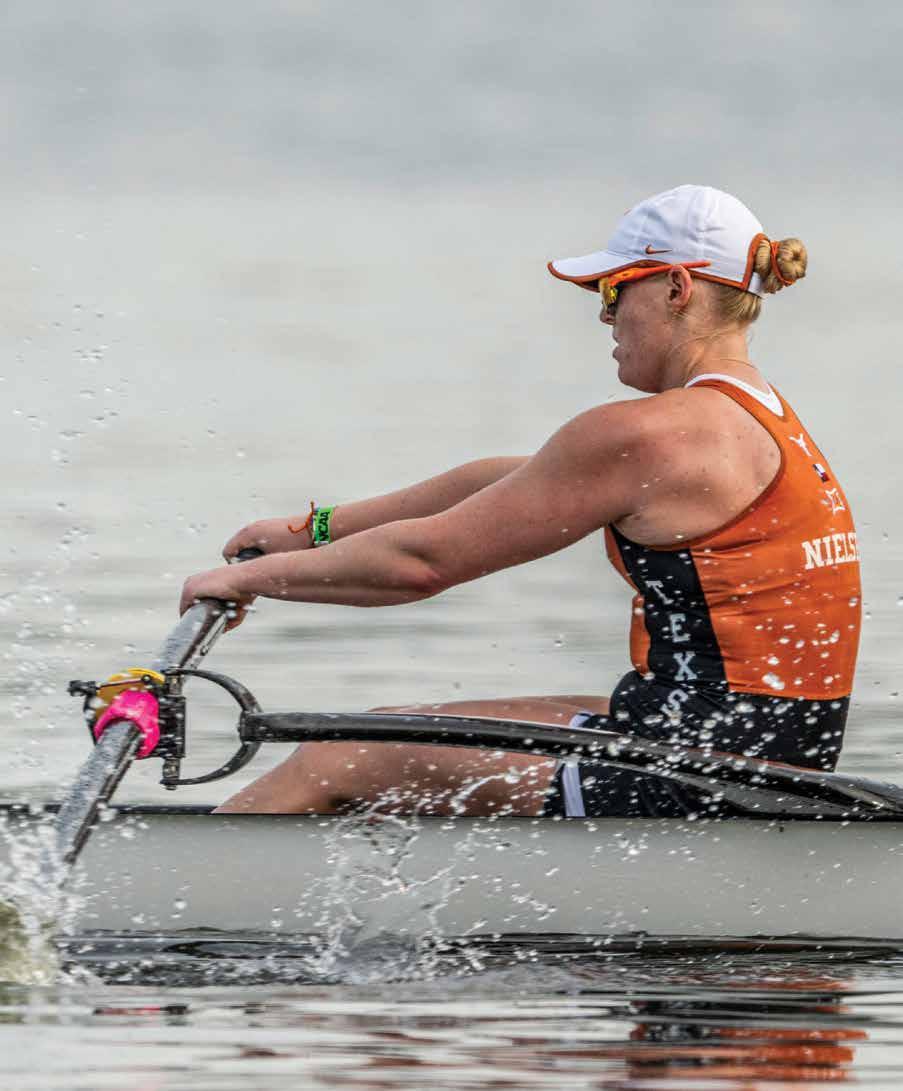
with the team win by merely three points over the Cardinal (127). The top of the team standings was rounded out by Tennessee (118), Princeton (112), Washington (106), Brown (99), Michigan (90), Yale (88), California (84), and Penn (77).
After winning their first two championships in 2021 and 2022, the Longhorns fell to fourth place last year. Coach Dave O’Neill learned from the experience, and the development that ensued spurred the team to victory this year.
“We would not have had this year without last year, and this team was fully committed and focused from day one,” said O’Neill. “We went back to some things we had done in previous years in terms of training and that instilled some real confidence in themselves and their teammates.”
Texas was clearly on a mission all year, beginning the season with a win at the San Diego Crew Classic and a sweep of all races at Michigan. Texas then cemented its title aspirations with a win over then No.-1 ranked Stanford at the Longhorn Invite.
The crew rounded out the season with a ninth-consecutive sweep of the Big 12 Championship.
“The athletes definitely felt prepared for anything on race day, and they certainly needed it with such intense racing,” O’Neill said, as he reflected on another dominating season. “I’m proud to be part of it, and it was wonderful to witness.”
Following closely on the Longhorns heels, defending 2023 NCAA champion Stanford finished second in the overallpoints standings this year and raced to victory in the second varsity eight event, finishing second in the varsity eight and third in the varsity four.
This is the fourth consecutive year that the Cardinal have finished top two at the national championship. The squad also won its third-straight Pac-12 championship, which is sure to be the last as the university joins the ACC next academic year and the Pac-12 rowing championship dissolves.
No.-3 ranked Tennessee lived up to that rank and finished third in the points standings, the best-ever finish for the Lady
Vols, who the past two season didn’t even qualify for NCAAs.
New head coach Kim Cupini and her squad finished third in both the first and second varsity eights, while capturing fifth place in the varsity four.
“This year’s performance and podium finish were epic for the team and staff, especially in this first year with all the changes and challenges that come with building a different program,” Cupini effused.
“There’s no doubt that Tennessee rowing will continue to race for the top in the years to come. I was truly honored to coach these women this year and work alongside some awesome staff. This season was just the beginning, and we are all excited to continue building this new precedent for Tennessee rowing.”
Before the DI championships wrapped up, the Division II and III national champions were named on Saturday. In the DII field, Western Washington earned its ninth national championship, winning the varsity eight event and finishing fifth in the varsity four.
The Vikings led the eight wire to wire, finishing over a boat length ahead of Mercyhurst, which was ranked just sixth in the last Pocock CRCA Coaches Poll before the championship. Defending champions Cal Poly Humboldt finished fourth overall, runners-up in the varsity four and fourth-place finishers in the varsity eight.
This was the tightest, most competitive field in the history of the DII NCAA championship, as the top four teams were separated by a mere four points: Western Washington (22 points), Mercyhurst (21), Central Oklahoma (20), and Cal Poly Humboldt (19).
Previous pages : Dane Mette Nielsen won the 2022 NCAA second eight event rowing for Yale and stroked the 2024 Texas varsity, coxed by senior Carly Legenzowski, to the Longhorns’ third national championship as a graduate student.
Right : Cal finished ninth overall at the 2024 NCAA Championship, marking the 25th year in a row the Golden Bears have earned a top-10 finish at the national championship regatta.

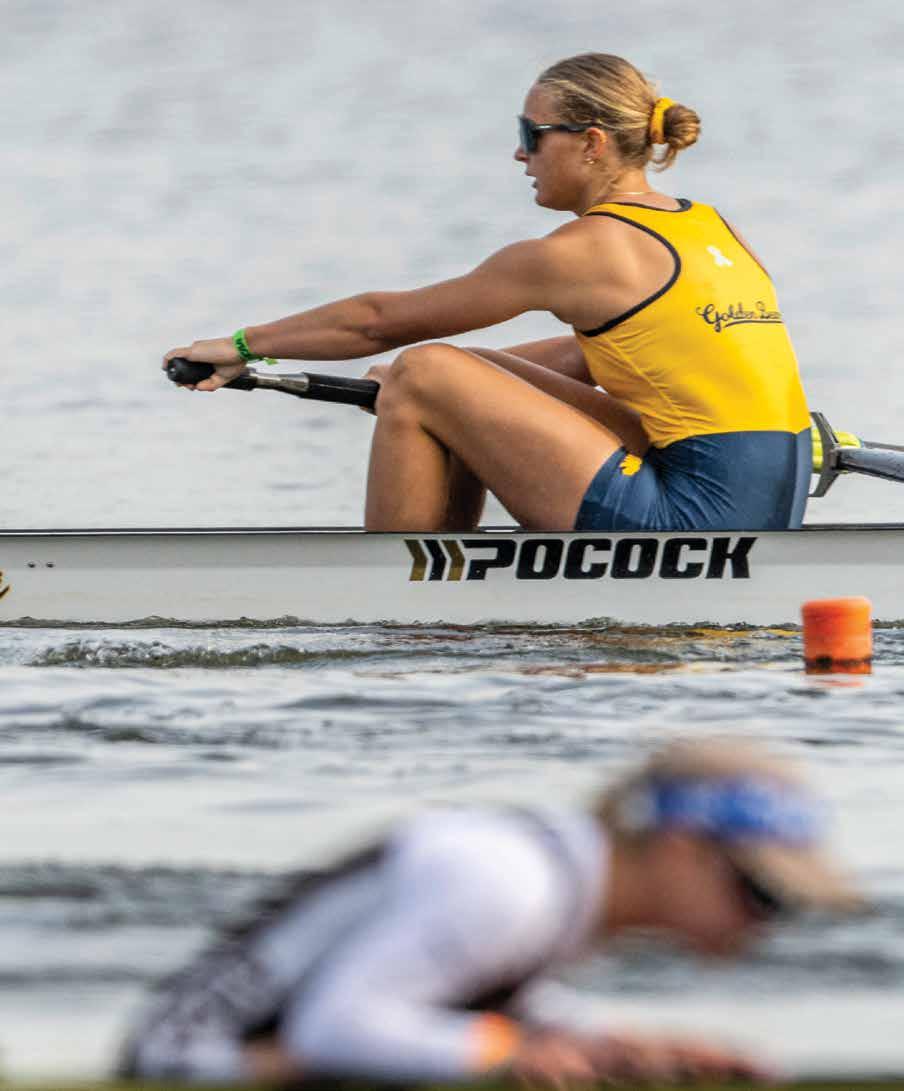
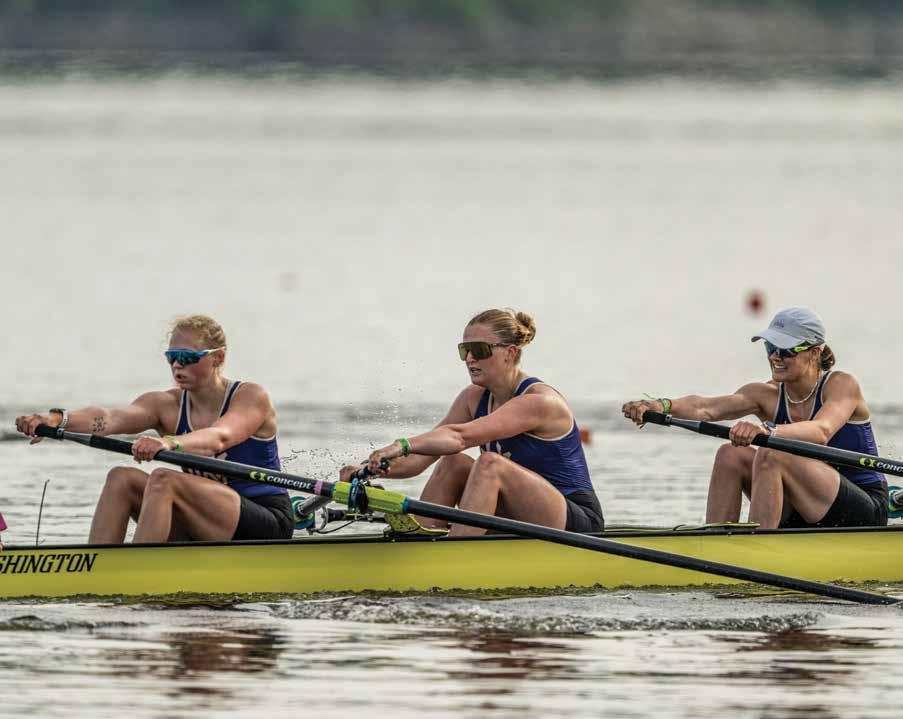
Tufts earned its first-ever NCAA DIII championship after a strong performance in the varsity eight, which the Jumbos led from the 500-meter mark to the finish, coming in over three seconds ahead of Wesleyan, which also finished second in the points standings.
Williams, which defeated Tufts in the heats on Friday, finished third. The Tufts second varsity eight finished second behind the Ephs, who finished third in the points standings.
Tufts was led by first-time head coach Lily Siddall, who began with the Jumbos in 2019 and was promoted to interim head coach last summer. Since then, Tufts has had an outstanding year, winning the collegiate eight at the Head
of the Charles, the points trophy at both the New England Rowing Championships and the National Invitational Rowing Championships, and the program’s firstever New England Small College Athletic Conference title.
“It’s been a great year for Tufts rowing due to the hard work of the whole team,” Siddall said. “We are lucky to have five eights of really strong, motivated, smart athletes. I’m also very lucky to work with other great coaches. The success we had this year was built on the foundation that so many Tufts rowers have set before us.”
Causes for celebration came throughout the field, not just for those on the podium. In addition to the top three finishers, both Princeton and Washington
The University of Washington advanced to the grand final of all three Division I events at the NCAA Championships, earning fifth place overall. The Huskies have 19 top-five finishes in the 27-year history of the regatta.
advanced all three crews to the grand finals. Indiana finished 15th, its best finish since 2019, after placing second as a team at the Big Ten Championship, the team’s best-ever result.
For the first time in program history, West Coast Conference champions Gonzaga advanced all crews to the C finals, and Jacksonville’s varsity eight finished 21st, the best-ever finish for not only the Dolphins but also for any Metro Atlantic Athletic Conference team.
The national-championship regatta for women’s rowing made it painfully plain that it’s time the NCAA got its priorities straight.
On the NCAA website under “Mission and Priorities,” one of the priorities listed is to “deliver excellent and inclusive championships.” On the weekend of June 2, the 2024 NCAA rowing championship was held outside of Bethel, Ohio, and it was far from excellent and inclusive.
As the championship event for all DI, DII, and DIII women’s rowing teams, the event drew over 800 female athletes. But this year, like past years, did not feel like a championship-caliber event, and it’s time the NCAA got its priorities straight for women’s rowing.
On our way in, we saw no signage directing athletes or spectators to the event, never mind a banner advertising it or welcoming athletes to their national championship. The only clue about what was going on at the park that weekend was a minuscule “Regatta” sign with an arrow pointing toward the parking lot. While this complaint may seem “petty” and “entitled,” this made the event feel like an afterthought, and certainly not like a national championship for over 800 athletes.
Multiple teams, including my own, were assigned spots next to the portable toilets. We had to unload our trailer, rig our boats, and warm up for competition while smelling the waste, which made some of my teammates nauseous and could have hindered their athletic performance.
In planning the event, this disturbance could have been avoided easily. Not to mention these outdoor bathrooms were used by all the athletes and staff, including male staff. They were the only private place where athletes could change. How is this “excellence” and “inclusivity” when we as women had no dedicated place to change and go to the bathroom separate from our male coaches?
Due to the outdoor nature of rowing, we don’t have access to locker rooms that most other sports do. For event planners,
providing a space for us to change and go to the bathroom, even if we share it with other teams, should be a matter of utmost importance.
Moreover, our hotels were a 40-minute drive away, and there was nowhere comfortable to change before beginning the journey back. Sitting in sweaty clothing for 40 minutes is unsanitary and could be a health hazard. There were also no handwashing stations available, a basic hygiene necessity that should always be provided.
In the past, a trophy has always been awarded to the fourth-place team. This year, that team was Princeton, whose members arrived at the podium for the trophy ceremony only to learn that no trophy would be presented. Regardless of whether it was stated in the event handbook, the coaches should have been told about it explicitly during their meeting.
When you expect a trophy for your athletic achievement, it’s very disappointing to find out there is not one for you. I realize that most sports don’t have a fourth-place trophy, and in the grand scheme of things it’s understandable why the NCAA doesn’t provide one anymore (for many sports, not just rowing). But the fact that the change in policy was not made abundantly clear before the competition was extremely inconsiderate.
Furthermore, the spectator area was arranged poorly. The big screen was set up behind the spectator bleachers. This is comparable to the big screen of a horserace being behind the grandstands. Sure, you can still squint at the race on the other side of the track, but wouldn’t it be better to watch it on the big screen?
Under “Grow the College Sports Ecosystem” on the NCAA’s list of priorities, a bullet points states that the NCAA will “enable quality access and viewing for all who want it.” The spectator area at this championship did not measure
up to what the NCAA supposedly aims to provide.
The live streaming of the event also was not up to par with the NCAA’s stated goal. The live footage didn’t do the racing justice. You couldn’t see the effort or the emotion that went on inside of the boats. The reason rowing isn’t considered a spectator sport is that the people in charge of covering it do the bare minimum and provide no sense of passion. Where are the up-close shots of the athletes at the start line? Where are the names on the screen identifying who’s in what boat? When you show the emotion within the sport and make it personal, you build passion for the sport and the people.
My frustration is specifically with the NCAA, whose interest in women’s rowing appears to be solely to comply with Title IX, not to grow the collegerowing ecosystem, as its mission statement claims. All I’m asking for is a little more respect for rowing and more effort put into our competitions. Other sports, such as volleyball, track & field, basketball, and softball, have been elevated and put into the public eye through collegiate athletics. The opposite is true for rowing.
Ironically, rowing was the first collegiate sport and has an interesting history that influenced the structure of many other sports. The Olympic committee borrowed a lot of practices from the Stewards of the Royal Henley Regatta, the most prestigious regatta in the world. People used to come from all over to watch college teams compete, and now the pinnacle of women’s rowing in the U.S. is hidden away, 40 minutes outside of Cincinnati, Ohio, in the middle of the woods.
When it comes to rowing, the proclaimed priorities of the NCAA have been ignored, and it’s time that changes.


HUSKIES RECORD HISTORIC WEEKEND, PRINCETON WOMEN REPEAT AS LIGHTWEIGHT NATIONAL CHAMPIONS, AND HARVARD LIGHTS GO ONE-TWO.
The University of Washington swept the heavyweight events at the 121st IRA National Championship Regatta, winning the first, second, and third varsity eights on Sunday, June 2, after winning the varsity four on Saturday on Mercer Lake, in West Windsor, N.J.
“It’s a good day,” said Washington head coach Michael Callahan. “Sometimes you can tell when boats have a certain energy and confidence, and I felt like if we had a good piece today, we could do it.”
Cal head coach Scott Frandsen, whose Golden Bears enjoyed an historic sweep of heavyweight events at last year’s IRA, came into this year’s regatta with an improving crew and optimism, despite having dropped the regular-season dual meet and Pac-12 championship to bitter rival Washington.
“We have three crews that have built really well over the last couple months, last couple weeks, and have a real chance here,” said Frandsen before Sunday’s grand final.
Princeton University, undefeated in the regular season, entered the Eastern Sprints two weeks before the IRA as the No. 1-ranked crew in the nation before being upset by a tenth of second by Brown. Little did they know that the Eastern Sprints heat would be the last time they would be first across the line. At the IRA, the Tigers finished behind Harvard University by 2.5 seconds in their Friday heat, before finishing second to Washington by less than half a second in the faster semifinal.
This year’s IRAs featured a new heats-semis-finals progression that dispensed with the regatta’s traditional repechage round for crews that didn’t win their heat to earn places in the semifinals, usually the best races of the year.
“There might be coaches who disagree, but it seemed like the crews that should have been in the A/B semifinals were in the A/B semifinals,” said Dartmouth College heavyweight head coach Wyatt Allen. “I feel like the benefit of no reps is everyone had a fair shot at making the grand final. That’s all you can ask for.”
The new format worked, in terms of the best 12 crews racing in the two A/B semifinals, but there was definitely a faster and
CONTINUES ON PAGE 50 >>>
STORY BY CHIP DAVIS PHOTOGRAPHY BY LISA WORTHY

The Pac-12 regatta was the only major championship to feature men’s and women’s collegiate varsity programs competing at the same venue on the same day. Both recently and historically, they were the best.
The University of Washington’s 2024 Pac-12 rowing championship will be the last one ever, as most of the member schools of the Pac-12 leave for other conferences. It’s a result of the college sports world’s chaotic conference realignments as schools chase massive TVrights payouts.
Washington, Oregon, USC, and UCLA will join the Big Ten, while the latest reports have Oregon State and Washington State remaining in what’s left of the Pac-12 and playing football games against schools in the Mountain West conference.
men and women rowing together, and that probably won’t happen going forward in the Big Ten.”
“It’s sad that the Pac-12 is coming to a close,” said Cal men’s head coach Scott Frandsen, who, like Callahan, raced in it as an undergraduate at the school he now coaches.
“When we went into the Big Ten, the first phone call I made was to Scott Frandsen, saying, ‘We’re going
“We need to evolve, and it might be an opportunity. It’s not all negative.”
Arizona, Arizona State, Colorado, and Utah will join the Big 12. Cal and Stanford—which row on waters that flow directly into the Pacific Ocean—will join the Atlantic Coast Conference.
From a rowing perspective, it makes little sense. The Pac-12 regatta was the only major championship to feature men’s and women’s collegiate varsity programs competing at the same venue on the same day. Both recently and historically, they were the best.
On the men’s side, Cal (2023) and Washington (2024) swept the heavyweight events at the IRA National Championship Regatta the last two years. Washington has won the James Ten Eyck Memorial Trophy for team points 18 times, more than any other program in the IRA’s 121 years.
On the women’s side, a Pac-12 school has been first or second at the NCAA championships every year since 2012. They’ve won 11 of the NCAA Division I championships since its inception in 1997 and finished second 14 times.
“It’s definitely very meaningful to our program to win the last Pac-12,” said Washington coach Michael Callahan, whose Huskies earned their 41st, and last, Pac-12 league title on Lake Natoma in May.
“It’s bittersweet. It’s one of the only collegiate conference championships with
—Michael Callahan
to be rowing the dual,’” said Callahan of the storied race between the fierce rivals and the country’s best two men’s rowing programs. “That is a pillar of our program—and hopefully their program, too—and we’re going to continue that tradition and that race first and foremost.”
The loss of the Pac-12 regatta might have a silver lining as rowing programs figure out their place and opportunities in the changing world of intercollegiate athletics.
“We need to evolve, and it might be an opportunity,” said Callahan at the IRA. “It’s not all negative. It might be a way to re-look at men’s rowing, rowing in general, and United States collegiate rowing. How do we improve it?
“The landscape of intercollegiate athletics is so dynamic. There’s going to be a lot of disruption, as there has been already, and it’s going to continue probably for the next 18 months. It’s going to look different every fall we show up for the next few years. And so we have to be prepared for that. We have to be resilient. We have to be able to adapt quickly. I think rowing will stay more regional.”
Cal’s Frandsen agrees. “We’ll find ways to continue to have our West Coast championship.”
slower semi, with the former relegating Sprints-champion Brown to the petite final—which Bruno won by a length with a time faster than all but the medalists in the grand final.
Syracuse University kept alive a four-year streak of making the national championship grand final by finishing third in its A/B semifinal.
had shown great sprinting chops at Sprints and again at the IRA, sprinted across the line third, just ahead of Cal.
“You don’t ever count on a sprint like that,” said Allen, “but we kind of knew they had it in their back pocket.”
Washington’s third varsity proved to be the Huskies’ most dominant eight, racing into the 5:30s in winning the grand final after progressing through the Friday heats and Saturday semis undefeated. In rowing, times are not comparable because of varying conditions, but any varsity, let alone a third varsity, covering 2,000 meters in that time is fast.
“Our mentality going into it was to eliminate all the noise and just row the race that we know we could row.” —Anya Cheng
“They started talking at the beginning of the year about not being the guys who let the streak end,” said Syracuse head coach Dave Reischman. “At the start of the year, it wasn’t grand-final speed—just day by day, getting a little bit better, just ‘OK, what’s the next step, what do we need to do?’ One of the best feelings as a coach is when you work on something in practice and you see your guys actually execute it out on the racecourse.”
Princeton coaches Greg Hughes and Matt Smith, who in head coach Hughes’ telling function more like two head coaches than a head and an assistant coach, embrace new technology and spent much of Sunday looking at their smartphone screens. They could have been watching the Overnght livestream, which worked better on phones than the jumbo screen—that froze midway through the national championship grand final.
What that screen didn’t show was Washington leading a tight race with authority and efficacy, outlasting a fast and challenging Harvard varsity, the only crew to beat the Huskies to the line during the spring, a late-sprint victory at the Sarasota IRA Invitational in March.
“When it’s going well, it’s contagious,” said Callahan. “The boathouse has been so great that way. It’s been really good internal competition that has raised each other up.”
The second varsity heavyweight event featured Washington, day after day after day, as the Huskies won their heat, semi, and grand final each by more than two seconds. Princeton finished solidly in second for silver, and a Dartmouth JV that
“I’ve been really fortunate to have an amazing staff this year,” said Washington head coach Michael Callahan, “Nate Goodman did an amazing job with the group.”
Fours—men’s varsity and lightweight, and women’s lightweight—drew bigger fields than the corresponding varsity eights due to the regatta’s qualifying protocols. The men’s fours event utilized time trials to set semifinal fields, another relatively novel feature of the 121-year-old regatta.
The varsity fours, in which Washington won the time trial, its semi, and the grand final to start the Huskies’ heavyweight sweep on Saturday, drew 35 entries, the most of any IRA event. Dartmouth finished second for the Big Green’s first of two heavyweight men’s medals at the regatta. Florida Institute of Technology made program history by winning the bronze, its first-ever IRA medal. In June 2022, the university president announced its intention to cut the program, but six oarsmen filed a Title IX lawsuit and the program was reinstated in 2023. With no seniors in the Florida Tech crew, a second medal could come as soon as next year.
Princeton repeated as women’s lightweight national champions, winning the varsity eight and adding the points trophy with a silver in the double and a bronze in the four.
“What we’re most proud of is winning the team-points trophy again,” said coach Paul Rassam. “That’s not easy for our team. We don’t get a lot of recruits. They’re ferocious racers, whether they’re in first, second, third, fourth. There’s only so much of that you can teach.”
Stanford University won the women’s
lightweight four. Boston University—only third in a semifinal where the top three finished within three-tenths of second— crossed the line second.
Boston University won the women’s lightweight double, the only sculling event and the only other Olympic event besides the men’s eight.
Harvard’s men’s varsity lightweights led start to finish to add the national championship to their Eastern Sprints title.
“IRAs is different just because IRAs is so much more drawn out,” said coxswain Anya Cheng. “There’s a lot of time to sit and wait and think. Our mentality going into it was to eliminate all the noise and just row the race that we know we could row. We knew that when we hit our top speed, we were going to win. So we just focused on that.”
In the men’s lightweight second varsity eight grand final, the top six crews went under six minutes over Mercer Lake’s 2,000-meter course, with Harvard’s second varsity repeating its first boat’s gold-medal success. Penn finished second, and Cornell was third, less than three-tenths of a second ahead of Navy in fourth.
Georgetown University, which did not race a lightweight eight, won the lightweight four event ahead of Columbia in second and Penn in third.
Wesleyan University held off Williams College by two-tenths of second to win its first Division III national championship. Both crews won their respective heats to set up a showdown in the final. Williams closed the gap with Wesleyan as they raced to the line, but the Cardinals held on—barely—for the win, the first ever in rowing for the Connecticut school, and only its third in any sport. After failing to qualify for the inaugural IRA Division III national-championship regatta in 2022, Wesleyan finished second in 2023 and completed a perfect season in 2024 by winning seven races.
Phil Carney, the longest-serving coach in any sport at Wesleyan and a steady presence in the boathouse for 37 years, deserves credit for capturing the Cardinals’ first Division III national championship.
Commissioner Gary Caldwell retired at the end of the regatta, his 31st in the role.
“It’s been an honor and privilege to serve the student-athletes for all these years,” said Caldwell.

Brown’s heavyweight varsity was ranked sixth, and illness claimed their seven-seat. Nevertheless, in the Eastern Sprints final, Bruno kept coming and won by a tenth of a second—defeating two crews that had been top-ranked during the season, plus the seven-year defending champions.
“One thing that helped was the focus to go all-in together and not worry about anything else—including the result.”
That’s how coach Paul Cooke began to explain how the sixth-ranked Brown heavyweight varsity, which lost their seven-seat to illness the week before, managed to win the Eastern Sprints, the championship for the Ivy League plus seven other top rowing schools.
During the season, they’d lost to Princeton, lost to Harvard, lost to Yale twice, and then came back to win one of the greatest Eastern Sprints finals ever—a final so close that no one on the water knew who had won when it was over (including the commentator who called it for Princeton and signed off promptly without confirmation or correction).
At the beginning of the spring season, Brown traveled to Florida to face most of the top programs in the country— Harvard, Northeastern, Stanford, Washington, and Yale—at the Sarasota IRA Invitational. On both days, they lost.
“We lost everything in the first 500 meters and we held steady for the rest of the course,” recalled the unflappable and inherently positive Cooke. “We were a length down in the first 500 meters to three crews that were dead level. And
we finished a length down, so I was like, ‘All right, for March, we’ve got good endurance. Everyone else is faster off the line.’ But it’s not easy to hang on the stern deck of three crews that are fighting it out at the very top level. So I actually thought we had pretty good stubbornness there and was encouraged.”
Brown’s varsity returned home to Providence for an up-and-down regular season, earning cup wins against Northeastern and Dartmouth before ending the regular season by losing the Content Cup at then national No. 1-ranked and undefeated Princeton. Then they lost one of their top oarsmen to illness, and switched out the stern pair.
At Sprints, the Brown varsity won its heat by four seconds over Yale, but ended up in lane 0 for the final, when a seven-boat field was necessitated by Northeastern’s being given a spot in the grand final after hitting geese on the course during its heat, in which they finished third. (Normally, the top two from three seeded heats advance to the grand final.)
In the grand final, Cooke admired seven-year defending champion Yale’s approach, jumping out to a length lead.
“For Yale to go out the way they did,
that showed so much audacity.”
The Elis, who finished third, were chased by Princeton, Harvard, and Penn. But in the last 500, Brown kept coming and took the victory at the line—by a tenth of second. But how?
“The answer is a couple things. One is, you never know,” said Cooke. “How do you do anything? You never really know.
“Jack [DiGiovanni] did a nice job at cox to orchestrate that. But they all did a good job with it.”
Cooke credits also his assistant coaches, Rufus Biggs and Scott Cockle.
“Those two guys have done a really good job” bringing perspectives on training that are “science-based and also programbased. We look at it like you have four years of college to change your physiology—a little bit like you’re doing an Olympic cycle.
“It’s definitely a very experienced group. They did a good job of keeping engaged and enjoying the practices. They wanted to come down every day and get better. They enjoyed competing and each other’s company and didn’t get too upset [by losses], and through the course of the year there was good leadership.
“They really worked hard for it.”.


THE 2024 ACRA CHAMPIONSHIP REGATTA FEATURED RECORD PARTICIPATION, INCREASING DEPTH, KEEN COMPETITION, AND THRILLING RACES.
The 2024 American Collegiate Rowing Association National Championship Regatta showcased nearly 2,000 athletes from 76 collegiate club programs from around the country vying for national titles, with a record number of entries on both the men’s and women’s sides.
“We can safely say we have rebounded from Covid and we are again the largest collegiate regatta in the U.S.,” proclaimed Gregg Hartsuff, head coach of men’s rowing at the University of Michigan and a former president and now secretary of ACRA, at the annual meeting.
“The state of club rowing is strong and seems to be getting better,” declared Dan Wolleben, president of ACRA and head coach of the Bucknell University men.
Indeed, the increasing depth of collegiate club racing was on vivid display at this year’s championship regatta, where there were first-time winners in the men’s varsity eight, women’s varsity eight, men’s team points, and several other events. Parity across the field showed, with 12 different programs winning the 13 men’s events and seven distinct teams winning the eight women’s events.
STORY BY MADELINE DAVIS TULLYPHOTOGRAPHY BY ALYSHA RATTANSI
Vanderbilt improved on its 2023 silver medal to win the Commodores’ first-ever ACRA varsity eight championship.
“Nobody is going to sweep the ACRA regatta, but everyone is going to get some great racing,” Wolleben said. “This is the main reason the regatta continues to grow— the athletes have something to set their sights on at the end of the season, they know they will get good racing in against great competition, and they can work toward program progress in the events that they enter from year to year.”
It was a record-setting day for not just the Vanderbilt women but the entire team.
“We operate as one program,” Miller explained, “so it was also great to have the men’s quad and men’s frosh four both earn silver, especially since those two boats and the women’s eight were battling it out everyday in practice on Percy Priest. The eight’s winning also put us in the top 10 in team points for the first time in the history
The club rowing world is healthy and growing at the ACRA championship, which in many ways represents the traditional heart and values of rowing better than anywhere else in collegiate rowing.
That competitiveness extends throughout the field. Five of the last seven races at this year’s regatta—the men’s varsity eight A, B, C, and D finals as well as the A, B, and C women’s varsity eight finals— featured at least one official photo finish on the HereNow results.
On the women’s side, Vanderbilt beat Purdue to the line by less than three-tenths of a second, avenging last year’s silver medal and winning its first-ever ACRA varsity eight gold medal.
“The win in the women’s varsity eight was huge for our program,” said Jon Miller, head coach of the Vanderbilt women and men. “The year overall was a blast. The women were locked in to see how many boats we could get in grand finals and if we could take gold in the eight, after our silver at ACRA in 2023.”
The Commodores placed three women’s boats in the grand finals, as their single finished fourth and their pair finished sixth.
Miller knew throughout the year this group of athletes was unique.
“This boat was a special bunch,” he said. “It was led by a strong group of seniors, but each athlete played an integral role in the success of the season and in the weekend in Oak Ridge.
“We tried a few different combinations over the spring and felt like we had a solid lineup finalized about six days before we loaded the trailer for ACRA. The eight did a great job staying loose but focused once we arrived in Oak Ridge and built some solid momentum over the course of the weekend.”
of our program, which was an even better way to cap the weekend.”
The men’s varsity eight final was no less thrilling, as Notre Dame won its first-ever ACRA championship by 1.5 seconds. Just behind them, Virginia defeated defending champ UCLA by a mere four-tenths of a second.
Quinn Klocke, head coach of the Notre Dame men, credits the team success to a clear focus on winning this very race for years.
“We haven’t shied away from talking about winning ACRA over the past couple of years, even when we were still building the necessary speed,” Klocke said. “Our team culture has been built around the idea that results are a self-determined outcome, so winning this year validated that process, not just from a rowing perspective but also generally.
“This group bought into the idea that their competitive advantage would come from the quantity and quality of their training. Six guys returned from the 2023 varsity eight that placed third at ACRA, and each made massive strides both physiologically and technically. That group’s ownership, along with the addition of some newcomers, led to a level of commitment to the process that allowed us to overcome the challenges of this year.”
The Fighting Irish crew featured the most recognizable athlete at the regatta, Joe Kiely, who finished second in the world at the 2023 World Rowing Under 23 Championship in the U.S. eight. The crew
also had a true novice freshman, Aidan Walsh, proving that classic novice rowing, while fading at the NCAA and IRA level, is alive and well in club rowing.
It was also a good year to be a Boilermaker, as Purdue took home both the men’s and women’s points trophies. The victory by the men was unprecedented; they ended Michigan’s dominance of the points trophy after the Wolverines had won every one since the founding of the regatta in 2008. The Boilermakers halted that run after a big jump from fifth in the 2023 standings.
The Purdue women saw an even bigger improvement, as they catapulted from eighth in 2023 to the top of the standings at this year’s regatta.
It’s not only the Texas women who are experiencing rowing success. The Longhorn men won the ACRA men’s small-boat team championship, awarded to the best performers in fours, quads, pairs, doubles, and singles, for the second year in a row.
Speaking of small boats, persistence was rewarded at this year’s ACRA championship in the singles events. Sydney Deaton from Clemson and Ethan Penny from High Point won the women’s and men’s events respectively. Both Deaton and Penny finished third in the same events last year and came back this year to claim the top spot.
The club rowing world is healthy and growing at the ACRA championship, which in many ways represents the traditional heart and values of rowing better than anywhere else in collegiate rowing. Athletes are committed and humble. Some arrive on their college campuses with high-school experience, but many are discovering the sport at activities fairs and when current team members spot their height from across the quad and invite them to the boathouse.
Coaches are engaged with their athletes as well as with their larger rowing communities.
“The entire coaching staff and I are just so appreciative of the people who helped make this happen,” Miller said. “It starts with the athletes, of course. Then it’s the alums, friends of the program, our advocates at the university, and the masters at Nashville Rowing who share our water and the course with us in the morning.”
Vanderbilt was one of seven distinct teams winning the eight women’s events at the ACRA National Championships.


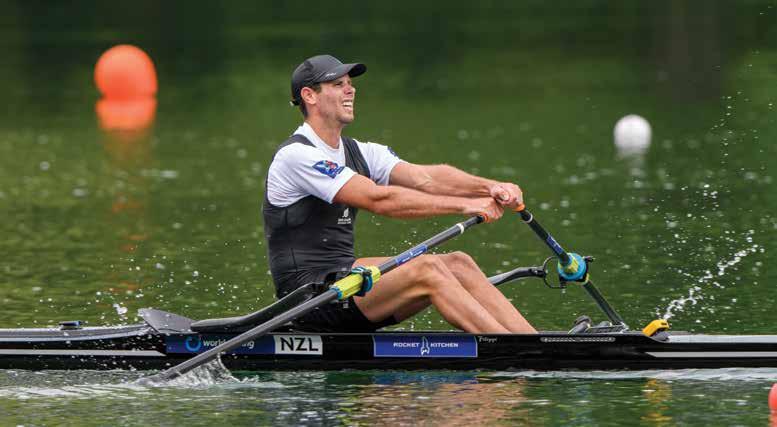
World records astonish us by stretching our conception of human potential. But in rowing, they are freak occurrences that happen only when there’s a confluence of favorable conditions.
World-best times fascinate us.
They signify a performance that no one has ever achieved before and that is unattainable by 99.9 percent of ordinary rowers. They are special also because, once set, they get only better.
What can we learn from them?
Not much (except that they’re amazing and inspire us to wonder about who accomplishes such feats). The reason is that they are so random. In fact, all the stars have to align: You need an outstanding team that is either challenged to perform at its best or in the mood to go crazy. And you need an internationally recognized event in the right place.
Record performances are recognized only on courses sanctioned by World Rowing, and of these, world-best times
have been set at only a few: Amsterdam in The Netherlands, Lucerne in Switzerland, Poznan in Poland, and Eton in the United Kingdom.
There are other places that offer the right conditions for fast times but for one reason or another they’re not on the international race list. The Olympic courses in Athens and Tokyo come to mind, and Indianapolis has a regatta course where best times were once set but that is no longer used for international competition. Although courses in Munich and Bled (Slovenia) often host international events, they cannot boast world-best times since the right conditions are needed for fast runs. Warm water and air temperatures are crucial, but above all the wind must blow intensively from the right direction at exactly the right speed for exactly the right
duration and without piling up too many waves.
If the wind speed or waves are too high, rowing is impeded rather than accelerated, or races will be postponed for safety reasons. The ideal: an increasing straight tailwind lasting long enough to move the water into a small current toward the finish line and then a big gust for the length of the race that delivers a push before there’s time to create big waves. Because such favorable conditions combine only briefly, world-best times are set in individual races and not during the entire regatta. And because such conditions occur haphazardly, world-best times are achieved often in preliminary rounds, such as the record rows of both U.S. Olympic eights as well as the Kiwi pair in their heats at the Athens and London Games,
Robbie Manson set the world-best time for the single, 6:30.74, at the 2017 World Rowing Cup, but finished only fifth at Worlds a few weeks later.25 lbs. 12 oz.
(lightest 1x in production)

Why a light boat?
• Less drag, more speed
• Lighter feel, higher stroke rate
• Easier to carry
How did we do it?
Single skin - kevlar/carbon
No paint on deck
I-beam frame
The lightest fittings:
• Dreher/Peinert rigger - 4.3 lbs.
• Dreher seat - 15.5 oz.
• Carl Douglas tracks - 15 oz.
• Carbon footboard - 15 oz.
• H2Row shoes - 19 oz.
• Molded bow ball - 1 oz.
$9,950 incl. options Made in USA

There’s no magical call that will close the gap when you’re down by a length, but here are three tactics that will help you catch up and pull ahead.
When you’re behind in a race (e.g., one length back), there are three things you can do to get back into it.
Before we get into that, though, let’s dispel the myth of the magical call. There isn’t one, because it doesn’t exist. You can have some motivational calls tucked away for moments such as this, but you can’t rely on them to be the game changer when you’re down by a length on the field or open water back. And no, I can’t tell you what those great motivational calls are because I’m not coxing your boat. In my experience, they’ve always been specific to my crew and the people in it, which is why knowing your teammates is so important to the calls you make.
Skipping the process outlined below and resorting to spouting platitudes for the rest of the race is akin to putting Band-Aids on a bullet wound; they’re not going to stop the hemorrhaging. It’s your responsibility going into race day to be confident in your Plan A but just as confident, if not more so, and comfortable pivoting to your Plan B when necessary. Fix the rowing. If you’ve fallen off the pack,
then it’s safe to assume that the quality of the rowing has begun falling off, too, particularly as the crew fatigues in the latter half of the race. Your first task is to reunify the crew by getting everyone to take the same stroke at the same time. Assuming you have a solid understanding of basic technique and the stroke your coach teaches, you should apply your knowledge of both to what you’re seeing and feeling to get the rowing back on track.
“900 meters in, one length back on Saugatuck. Let’s tighten up the timing and complete the strokes—we got this! The race starts right ... NOW! Squeeeze through squeeeze through —that’s it! Hold the back ends and breeeathe through the recovery … now. In our rhythm … let’s accelerate and swing together. Squeeeze swing … hands out together now … hands now … hands now … accelerate swing —there it is … accelerate swing…”
Match the speed of the crews in front of you. It’s hard to move on a crew that’s moving away from you, so before you can begin closing the gap, you first have to stop them from advancing farther. This
is where you need to watch the rate and make sure you’re at the pace you want to be. One tactic I’ve used in the past is raising our rate a beat to match the other crew(s) if it looks like they’re rowing higher than we are effectively. The risk-reward here is very high, so you have to make a quick assessment (mainly, can you raise the rate without spinning your wheels and then sustain that speed/pace for the next few hundred meters?) and then commit to executing it.
“11 hundred meters in, time to shut ’em down. We’re at 35 right now, we’re taking it up to a 36 … pick it up together on this one! LEGS commit , LEGS 36–right here, stay in this rhythm now and attack … legs loose … legs loose … get stubborn now, hold on to them … legs yeah middle four! Trust our rhythm, trust our speed … holding our margin now, that’s it…”
Make your move. The second you sense that the margin is holding, you have to capitalize on it and go. You can’t waste time or meters, because by this point you’re probably well into the third 500, which means you’ve got time for maybe one last 20 before it’s time to sprint. My crews tend to respond well to calls for commitment, so I work that word into a lot of my calls throughout the piece, largely to emphasize whatever broader thing I’m trying to accomplish.
“Four seats back now, guys, let’s close the gap and even it up over the next 10 … ready in two in one … commit NOW! One go! Two go! Three commit! Load together send … that’s it, WALKING! Two seats back now … it’s yours, take it! Strong with the legs, together in two … one … two, GO NOW! Legs go! Legs go! Do not sit, do not quit … together go! Bow to stern now, bow pair, reel it in! Six bend ’em ! Seven break ’em ! Eight break them! Nine last 500 … ten stay on it!”
If you find yourself falling off the pace of the other crews, evaluate the situation, make a smooth transition to your Plan B, and aim to keep the energy high. Making a successful comeback might not always be possible, but at the very least you should aspire to cross the line with pride, and the strategic calls you make are your best resource to facilitate that.
KAYLEIGH DRUMYes, it can be rough, so have someone to talk to outside of camp—a “rowing therapist” willing to listen and support. And beware of cliques!
Congratulations! You’ve been invited to selection camp. Whether for the Olympic team, the U19/U23 team, or pre-season tryouts for high school or college, how athletes approach the opportunity can determine their success.
Success at camp requires arriving prepared. This means being physically fit, healthy, rested, and enthusiastic. Find out ahead of time whether or not there will be erg tests at camp and, if so, prepare for them.
The erg test at selection camp is like a free throw in basketball; the pressure is on but it’s a golden opportunity to score some points. Balance training with good rest, since showing up exhausted or burned out is a quick way to miss out on selection. Same with an injury; get this addressed before camp.
Once at camp, recognize this fundamental disconnect: The coach wants to pick the fastest boat, but you, the athlete, want to make the boat. The more you can adopt the coach’s perspective of “how can I make this boat/team faster?” the better you’ll do in the selection process. If all you do is focus on trying to make the boat, rather than on making the boat better, you’ll be at odds with the selector and less likely to provide what the coach is looking for. Yes, you must be somewhat selfish, but by focusing on the greater good of boat speed, you help yourself best.
Camp requires flexibility and, ideally, curiosity. Things will be done differently than at home. Do not assume otherwise. It’s your responsibility to adapt and understand the purpose of what’s being asked of you. Why this training? Why this drill? If something doesn’t make sense, ask about it. It’s nearly certain that what confuses you is also confusing others (who may be too shy to inquire and attempt mistakenly to fake their way through). If something is unsafe— physically or emotionally—speak up, but otherwise save any concerns for after training. Selection camp is a full-time endeavor. Behave like a professional athlete. Prioritize
rest and recovery. Get to bed early, take naps, take care to warm up and cool down properly, and eat right.
Camp can be rough, so have someone to talk to outside of camp—a “rowing therapist.” It may be a coach at home, a teammate, a sibling, or significant other. It helps if they know rowing, but what really matters is that they’re willing to listen and support.
Beware of cliques. It’s valuable learning from those who’ve been to previous camps. Pay attention to their behavior if they’ve made the team previously, but don’t assume they have all the answers. Frequently, the “returners” will coalesce around each other and, intentionally or unintentionally, freeze others out.
This is destructive to boat speed because it hinders finding better boat-movers from among the newer athletes. Returners who do this may make the team but find themselves in a slower boat than they could have raced had they been open to others. New athletes can assume, mistakenly, that everything the returners do is worthy of emulating and the key to being fast; it’s not. Younger and newer athletes have to discern what’s worth imitating and what’s for show, and thus forgettable. New, unsure athletes can ask the coach who sets the best example and follow him or her.
Finally, don’t take it personally. Selection camp is designed to find the current best boat-movers, not the best people or the rowers with the brightest futures. If you make the boat, it means only that the coach thinks you’re a better boat-mover than others. If you’re cut, it means only that the coach thinks that today you’re not as good a boatmover as others.
Tomorrow is another day, and there’s a lot more to life than rowing.
BILL MANNINGSports dietitians and other exercise pros share the latest about carbs, caffeine, placebos, collagen, and “cycle-syncing.”
The American College of Sports Medicine is a professional organization for sport-science researchers, educators, exercise physiologists, sports dietitians and doctors. At its annual meeting in May, more than 4,500 members from around the globe presented their latest research.
Here are some highlights of the session hosted by the Professionals in Nutrition for Exercise & Sport:
Fueling endurance: How much carb is enough?
When athletes consume the recommended 30 to 90 grams of carbohydrate every hour during endurance exercise, they tend to perform better than athletes who fail to maximize their carb intake. Given that muscle might be able to take up 120 to 140 grams of carbohydrate per hour if the carbs can get through the gut, the question arises: Would more than 100 grams of carbohydrate per hour be even more beneficial, despite the risk of gastrointestinal distress?
Training the gut to tolerate a higher carb intake might take about a month or more. Hence, endurance athletes should practice their fueling strategies during training sessions to figure out their individual fueling and hydration sweet spot. The type of carb (liquid, solid, sports drink, energy bar) used for fuel doesn’t matter as long as you’re drinking enough fluid.
Caffeine for performance: How much is enough?
Caffeine is a popular pre-exercise energy booster, with some athletes being more sensitive to caffeine’s effects than

others. About 45 percent of athletes have genes that metabolize caffeine quickly; 45 percent, moderately; and 10 percent, slowly, meaning it stays in the system longer.
Despite this, caffeine’s rate of metabolism doesn’t dictate its ergogenic effect. Caffeine stays in the system for hours, even among fast metabolizers. There’s no solid evidence to suggest that other genotypes influence caffeine’s performanceenhancing effects. Given that caffeine’s benefits appear unrelated to a specific gene, athletes needn’t spend money getting “caffeine genotyped.”
Athletes can take caffeine in the form of pills (three to six grams of caffeine per kilogram of body weight; 200 to 400 milligrams for a 150-pound athlete) or drink some coffee (about 150 to 200 milligrams per 12-ounce cup) an hour before exercise—though be aware that coffee’s caffeine content is highly variable.
For a quicker fix, caffeinated gum (developed by the military) gets caffeine into the system within 15 minutes. Words of wisdom: More caffeine is not better; high doses can hurt performance, so plan to keep that upper limit to six grams per kilogram.
Placebos are powerful
When translated from Latin, placebo means I shall please. A placebo offers a pleasing effect and can enhance performance in its own right. For example, if you take a supplement that you believe in (it pleases you), chances are good you’ll be able to perform better, even if research suggests the supplement doesn’t work. The stronger your belief, the larger the effect. The supplement industry commonly exploits the placebo effect. Some companies make a lot of money from supplements proven not to work. That said, all supplements come with risks. Just because it works doesn’t mean it’s safe. Use supplements wisely.
Collagen supplements for tendons— questionable!
Collagen supplements are supposed to strengthen tendons and ligaments so such connective tissue is less prone to injury. Research suggests tendons can get bigger and stiffer with collagen supplements, but this has been shown to happen also with whey supplements. In muscle connective tissue, whey and collagen supplements are equally effective. Using collagen supplements to enhance skin, hair, knees,
joints, and other collagen-dense tissues is also questionable. If any small effect is seen, it’s more likely from having boosted your protein intake. Consuming adequate protein is essential for proper muscle, tendon, ligament, and joint health.
Several studies suggest that over 50 percent of NBA players start games under-hydrated, as well as 50 to 80 percent of other athletes. Does this impact performance? No doubt—just as it’s quite plausible that athletes would improve their performance if they were better hydrated. Most important: drinking enough water in hot weather.
Some athletes test their urine routinely to determine hydration status based on the concentration of metabolites. Given that each athlete is an experiment of one, having concentrated urine doesn’t mean necessarily that an athlete is dehydrated. For example, muscular athletes, like rugby players, tend to have darker, more concentrated urine than runners. Urine tests should be adjusted according to each individual’s baseline measurement.
Empowering a woman to track her cycle and monitor how it affects her is a big step forward for the sports world; only recently has menstruation been discussed by coaches and trainers.
Although recent research has found no definitive impact of the menstrual cycle on the ability of female athletes to perform, some women talk about symptoms, ranging from mild to very severe, that can lead to suboptimal results.
Cycle syncing—tailoring food and exercise to menstrual-cycle phase—is practiced currently by some athletes and teams, but there’s no strong evidence to support it, nor are there any firm physiological reasons to do it. Since belief is so powerful, we don’t want athletes to believe that at certain times of their cycle, they’ll perform worse.
If a team believes cycle-syncing offers benefits, it will.
information, visit NancyClarkRD.com.
Sports nutritionist NANCY CLARK, M.S., R.D., counsels both casual and competitive athletes in the Boston area (Newton; 617-795-1875). Her best-selling Nancy Clark’s Sports Nutrition Guidebook can help you eat to win. For more


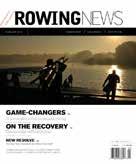


Skills developed through small-boat experimentation and play are transferable to a sweep boat.
Sculling in a single is like having a coach in the boat. The hull is so sensitive that it will respond to your every move, giving you immediate feedback. The warmer water of summer is a perfect time for small-boat experimentation and play that can be transferred to a sweep boat.
Sara Gronewold, the director of Craftsbury Sculling Camps, told me:
“The comfort-in-the-boat session is a highlight for many scullers. Having the opportunity to manage a single, while pushing the boundaries of stability, can release years’ worth of tension in how we carry ourselves throughout the rowing stroke. While the session often feels like fun and games, it ultimately leads to a generous increase in boat speed.”
Tricks can get challenging, like standing up in a boat to juggle, but Bob Reichart, director of coaches at the Capital Rowing Club in Washington, D.C., leads an entry-level comfort-in-the-boat session that’s appropriate for new and older scullers.
The progression is as follows:
Safe position 1: hands locked around both handles with body in neutral.
Safe position 2: handles tucked inside
thighs, core, upper arms; blades feathered on the water for both.
Next, lower hands, lean over, and slap the blades on the water side to side. Progress to light hands and rock the boat—the goal is to dip the bottom of the oarlock pin in the water.
Next, let go of one handle, balance on the other oar, and wave “Hi, Mom.”
Then, practice drawing one oar past your body so it’s parallel to the boat, while balancing on the other oar.
Review the pause positions with blades on the water and hold at the full-reach position. Then, handles down and away to balance with blades off the water. Go to quarter slide and balance.
During the tapping drill, move from the release to the catch, blades squared, and try to tap 12 times.
Finally, practice spinning the boat in place with one oar rowing and one oar backing.
ROYLE
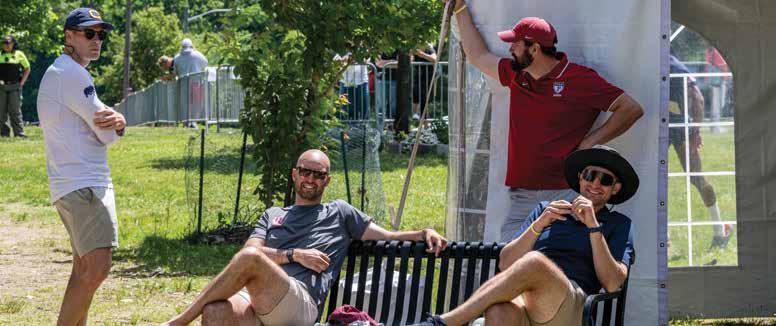
If you’re tempted to jump on the coaching carousel this summer, keep in mind these factors as you mull what’s right for you.
Summer is the time when many rowing coaches are contemplating their next move. The coaching carousel is spinning, and some coaches are doing everything they can to get on, or off, the ride. But a decision made in haste or out of desperation can do much more harm, personally and professionally, than no decision at all.
Coaching is viewed commonly as a linear hierarchical profession. You begin as a volunteer or low-level assistant. You move up to a full-time assistant, then first assistant at a better team. Then, you become a head coach somewhere and eventually a head coach at a more big-time team.
But this isn’t the only path. And it’s not usually the most fulfilling or sustainable one. Moving from collegiate to junior coaching is sometimes the best move, and sometimes making an outwardly lateral move is really the best one for you. Coaches can lose themselves running on this treadmill constantly looking for the right next move. What is “right”?
Only you can define that. Sometimes, you have a good thing going in your current position or you have outside life factors that make this the best option for the time being, so the right move is staying put. When it’s time to look for the next opportunity, thoughtful coaches would be well served by trusting themselves, not external evaluations, to identify the “right” position.
Some things to consider when looking for your next position:
- Philosophical alignment with leadership: Do your values align with whomever is in charge? If your priorities aren’t similar from the jump, they aren’t going to shift much over time.
- Job responsibilities: What is the actual job description? What will your responsibilities be? If the position doesn’t offer the opportunity to work on the areas you’re most passionate about or want to develop the most, maybe it’s not the best fit.
- School culture and location: Look beyond the rowing. Does the culture of the university or club, if you’re looking at
a college position, align with your values and interests? Is the job in a location you want to be in? This is a simple but often overlooked factor.
- Development opportunities: Make sure you’ll have real opportunities for professional development. Can you take on new responsibilities with which you’re unfamiliar? Will you be able to attend conferences? Will you have access to more experienced coaches within the department or boathouse?
- Fit: Don’t forget about this ever-elusive factor. This may be a feeling in your gut, or your chest. Don’t ignore it. When you talk to your potential future colleagues, are you excited or does something feel off? When you walk around campus or the boathouse, can you see yourself there? You may feel nervous or doubt your readiness (you’re ready!), but you shouldn’t feel off.
Good luck to those trying to hop on the spinning carousel, and congratulations to those who are satisfied with where they are.
MADELINE DAVIS TULLY COACH DEVELOPMENT

BOSTON
Massachusetts, USA
Thursday, Dec. 12 to Saturday, Dec 14, 2024
Washington, USA
Thursday, Feb. 6 to Saturday, Feb 8, 2025
The Women’s Coaching Conference serves all female rowing coaches, providing attendees with actionable education and community building to ma ximize their current positions and advance to the next step in their careers. The mission of the WCC is to educate, connect, and inspire emerging and established female coaches across the sport. The Winter ‘24-’25 conferences feature top-tier, professional presenters including leadership coaches, athletic directors, and leaders within the rowing community and beyond.
For more information, and to register for the event, visit wccconference.com Space is limited.
DOCTOR ROWING CON’T FROM PAGE 66
suppose we should be glad that rowing has a bot to expound on the sport. Has rowing finally made it in the social-media world?
My internet search proved fruitless. Why not ask a coxswain back before the dawn of time whether he had ever heard legitimate coxswains using the “Stroke! Stroke!” call? (I use “he” because let’s remember that coxswains were all male until women began rowing in the U.S. in 1938 (That’s right. Women could vote before they could row.)
I hunted down Bill Becklean, the coxswain of the Yale crew that won the gold medal at the 1956 Olympics in Melbourne. Bill is a spry 87-year-old who is still very involved with rowing, coaching at Cambridge Rindge and Latin High School in our fair city of Cambridge, Mass.
In fact, last fall, he rowed in the opening event on Friday of the Head of the Charles, the Grand Veteran Singles, and coxed the “Octogenarian 8” for Community Rowing in the last event
ADVERTISERS INDEX
of the regatta on Sunday, the Director’s Challenge mixed eight.
Bill, in all your many years around rowing, have you ever heard a coxswain use these commands?
“Never. It absolutely has never been part of what a coxswain says.”
There isn’t much that Bill hasn’t done in the sport of rowing. When Bill was a schoolboy at Phillips Exeter, his coach decided that it would be a good experience for the boys to go to the Olympic trials in 1952. They had, after all, won the New England Interscholastic Rowing Association boys coxed-four event. Why not shoot for the moon?
“We won our heat against Harvard and California and made it into the semifinals. But the wind shifted from tail to head and we were shown up for what we truly were–boys among men. I didn’t go to the Olympics with Exeter, but in 1956 I coxed the Yale crew that did.”
After losing to Cornell at the Eastern Sprints, Yale beat Harvard by 21 seconds and prepared for the Olympic trials. There was some drama with an early crab,
but the Elis pulled it together, moved through Cornell, and punched their ticket to Australia. The rest of the story is well known. Third in its heat on Lake Wendouree, Yale had to qualify for the Grand Finals through the reps. They did and rowed a fine race to win gold.
You know by now that Becklean did not urge his crew on by yelling “Stroke! Stroke!” He did do something that is no longer part of coxing—pounding on the side of the Pocock with wooden steering knockers and sending vibrations down the hull. Coxswains liked to think of this as a cattle prod to get guys shifting into another gear. Alas, modern boats do not use knockers to steer.
Sports can bring out some pretty dumb behavior. Have you ever been to a ballgame where some halfwit in the grandstand yells “Swing!” to a majorleague ballplayer? Or basketball fans who ride opposing players by inviting them to “shoot!” as soon as they touch the ball? Our ersatz rowing experts join this pantheon of heroes. Stroke, stroke, indeed!

No self-respecting coxswain would ever urge rowers to “stroke! stroke!” The command merely certifies that the user is a crewbaiting ignoramus.
Dear Doctor Rowing,
A long time ago, in a galaxy far, far away, when I used to be on the water with my crew, people on shore would invariably yell, “Stroke! Stroke!” as we rowed powerfully past them. Mortals jeering at the gods—who were these insects?
It hit me the other day when I was sculling that I haven’t heard that kind of malarkey in quite a few years. Thanks be to the rowing gods. It inspired a question: Was there ever a time when coxswains were coached to say these sixletter words or did coxswains themselves cry out, “Stroke! Stroke!”—presumably to keep the crew in time?
What can you tell me about this dead and buried phraseology that seems to have passed out of the lexicon of knuckleheads who liked to taunt us?
IIt’s hard to imagine that those guys who would shout at us thought that they were being clever.
know exactly how you feel. It’s hard to imagine that those guys who would shout at us thought that they were being clever. Or did they think that this would offend us so deeply that it would break our concentration and leave us in a weeping heap of cotton rowing trou? Where did this come from?
Apparently, it does still live on, as one Michael Damien BrookeBaker, a retired teacher from…you guessed it, England…posts to Quora.com
“I don’t know what the rowers themselves say, but the coxswain keeps the time by shouting, “Stroke! Stroke!”
Methinks that Mr. M.D. Brooke-Baker bears some lingering resentment from being left off the Junior Colts squad at one of England’s slowest rowing schools.
As I dove further into the murky waters of the internet, I found this from “Undercover Me” on Reddit.
“I often encourage smaller students interested in athletics to consider coxing if you can handle ordering around much bigger and stronger rowers, are OK with being a complete asshole at times, and don’t take unwarranted blame for everything personally. Coxes are a special breed and deserve a lot more credit than the ‘stroke... stroke... stroke...’ stereotype gives them! They must be exceptional at spatial geometry and managing high-stress scenarios.”
Well said, Undercover Me.
Much to my surprise, googling “Stroke! Stroke!” yielded not only some decent answers but also an AI bot named Poe. When asked for some good coxswain commands, however, Poe advised, “In two, we’re on the slide.” The Bot continued, “This command is used to synchronize the rowers’ movements during the recovery phase of the rowing stroke.”
(Never has Doctor Rowing heard this ridiculous call.)
Then pay dirt!
“When the coxswain or coach calls ‘stroke,’ the stroke rower takes the first stroke of the race or workout,” Poe continued.
Really? We should wait for a command to stroke? I

